Hold the phone. I just found out you can regrow food in water without dirt. Could gardening get any better when you have two black thumbs?
I think not. And my black thumbs aren’t the only reason I’ve been hesitant to garden. It can be costly too, but ever since I found ways to water my garden for free, I’m all over it.
Then my step-mom showed me how to regrow food in water – she had a couple heads of lettuce in a bowl in her kitchen. But as it turns out, it’s just one of several veggies that can grow without dirt, and without much effort too.
It’s great news for those buying organic vegetables, but even if you aren’t, it’s a simple way to stretch those grocery dollars just a teeny bit further is to regrow food in water!
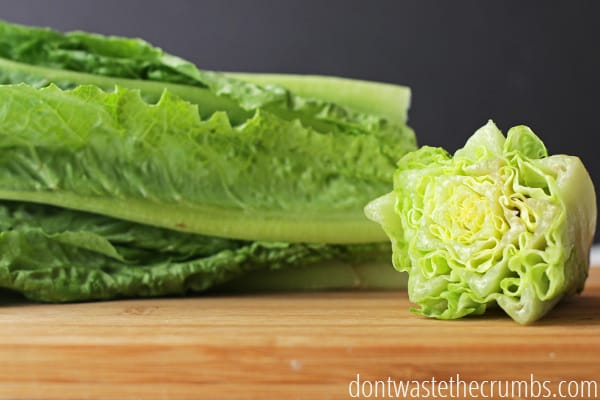
Why Should You Regrow Food in Water?
There are plenty of reasons to regrow food, but the most important ones to me are:
(1) It’s absolutely free.
You already bought the vegetable. All it costs is a few tablespoons of water – but if you’re smart about it, you can re-use water you’ve already used elsewhere, like from boiling pasta or water that you collected while waiting for the shower to get hot. Then it wouldn’t cost you a dime!
(2) It’ll trim your grocery budget.
Little ways to save money really do add up to bigger savings, as long as you’re diligent about using them.
Now, you won’t get a huge harvest out of any of these items, but it is still food and every little bit helps. Even if it’s a few leaves of lettuce to scoop your tuna salad with, you can regrow food you didn’t have before and won’t have to buy.
(3) It makes organics more affordable.
Affording organic food just got easier! If you start with organic food, you’ll regrow food that’s organic… so you’ll reap the benefits of organic greens without actually paying for them!
(4) It’s easy.
Do I have to explain further? I mean, stick the plant in water and watch it grow. Really – it’s that easy!
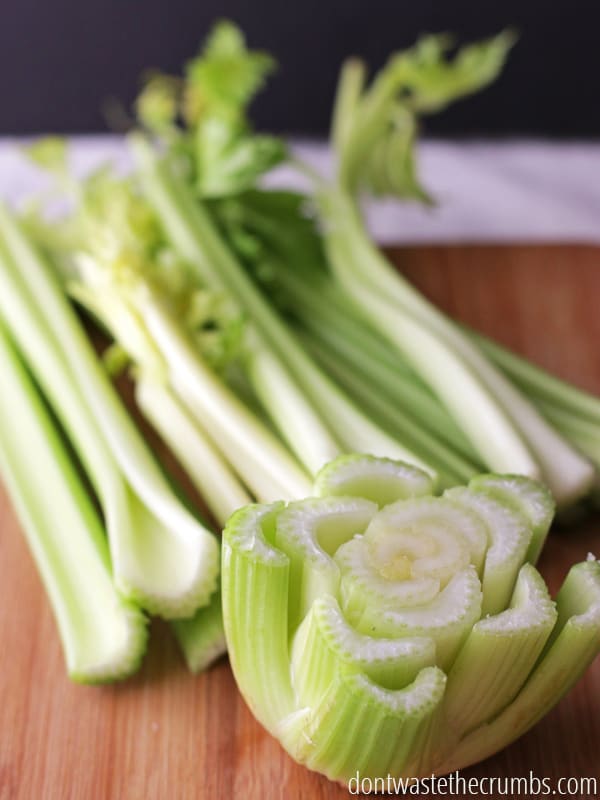
I’ve listed below all the vegetables that can legitimately grow in water and water alone.
Sure, there are plenty more that can START in water and then be transplanted to soil. And yes, beans will sprout in water too – but unless the vegetable will grow into more vegetable that can be eaten as-is with only a cup of water, I kept it off this list.
General Guidelines to Regrow Food in Water
- You don’t need a lot of water – just enough to cover the roots. About 1/2″ of water seems to be sufficient otherwise the food can get moldy and slimy.
- Be sure to check the water every 2-3 days to ensure that A) there’s enough water, and B) no rogue lettuce pieces fall off and slime up your bowl.
- The size of container should be relative to the size of the food you’re growing. Lettuce and celery grows best in shallow bowls like these. Green onion and lemongrass can be in taller, skinny glasses like these.
- You can regrow multiples of the same plant as long as you’re not overcrowding the area.
- I haven’t tried this myself, but using a fertilizer could help with the yield when you regrow food – especially if this is more than a fun side project. I would recommend this Dr. Earth organic liquid fertilizer or a hydroponic fertilizer.
10 Ways to Regrow Food in Water
Bok Choy
Cut off the bottom of the stalk and place in a small bowl of water. New growth begins from the center in 1-2 days with significant growth in less than a week!
Cabbage
Place the root end in a shallow bowl of water and watch it regrow from the center. Be sure to harvest on the smaller side to get the best flavor.
Carrot Greens
You can’t regrow an actual carrot, but you can regrow the carrot tops! Place the cut-off end of a carrot in a shallow bowl of water. Harvest the greens as they grow and add to salads. Better yet, make this amazing carrot top pesto and stop spending money on store-bought!
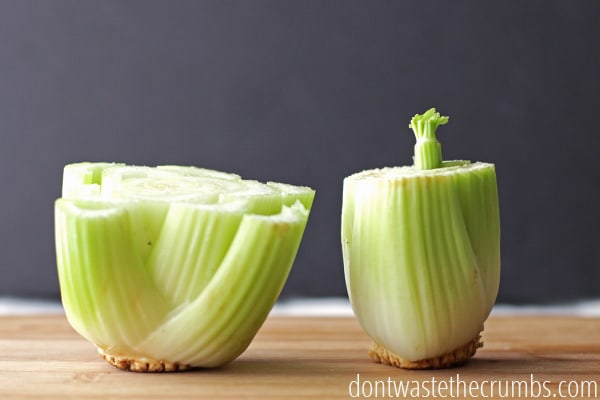
Celery
Cut off the bottom 2″ of the stalk and place in a small bowl of water. New growth begins from the center in 3-4 days. It might take awhile for a full stalk of celery to grow, but you’ll get great growth in the center for flavoring dishes. If you don’t know what to do with the leaves, dehydrate them, and make your own dried celery powder.
Fennel
Cut off the bottom 1″ of the base so that the roots are intact and place in a small bowl of water.
Garlic Chives
Garlic chives are the green that grows from a clove of garlic and can be added to dishes that traditionally call for green onion chives like salads and baked potatoes. Place a garlic clove in a small cup and add water to the bottom without submerging. Roots will grow in a few days and shoots will grow shortly after!
Tip: Garlic starts to lose it pungent flavor when the shoots grow, so if you find a rogue clove in your fridge or pantry starting to shoot, place it in a cup of water to grow chives instead of throwing the clove away!
Green Onion
Keep the white part of the onion with any roots that are in still intact. Place in a glass with water and you’ll have a never-ending supply of fresh green onion!
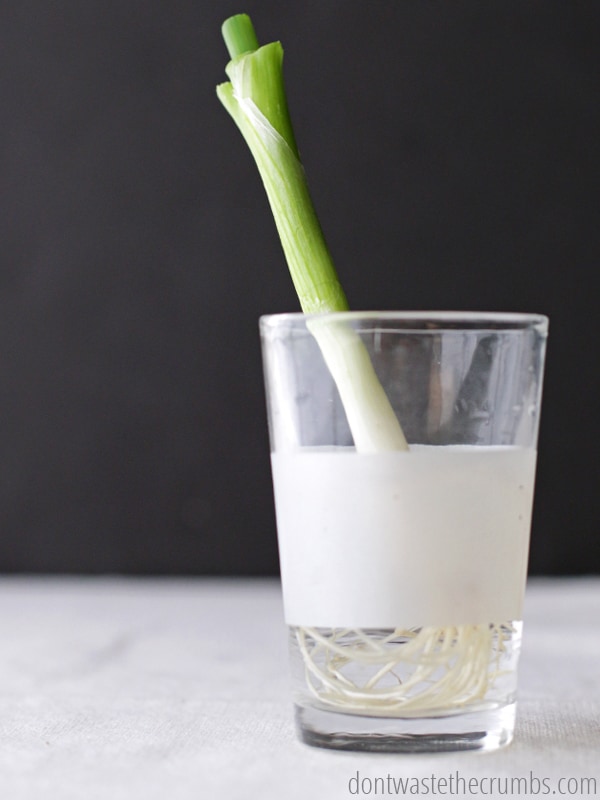
Leeks
Cut off the bottom 2-3″ of the stalk and place in a cup of water. New growth will come from the center of the plant. Usually only the green part of the leek is used in cooking, but it can be used interchangeably with onions for a delicious, mellow flavor.
Lemongrass
Cut off 2-3″ from the bottom and place in a tall container with 1/2″ or so of water. New lemongrass shoots will grow from the center.
Lettuce
Cut off the bottom of the head of lettuce and place it in a small bowl of water. New growth begins from the center of the in as little as 3 days and you’ll have a new half-head of lettuce in about 2 weeks. I’ve heard romaine re-grows best, but I’ve had success with green leaf and red leaf lettuce too.
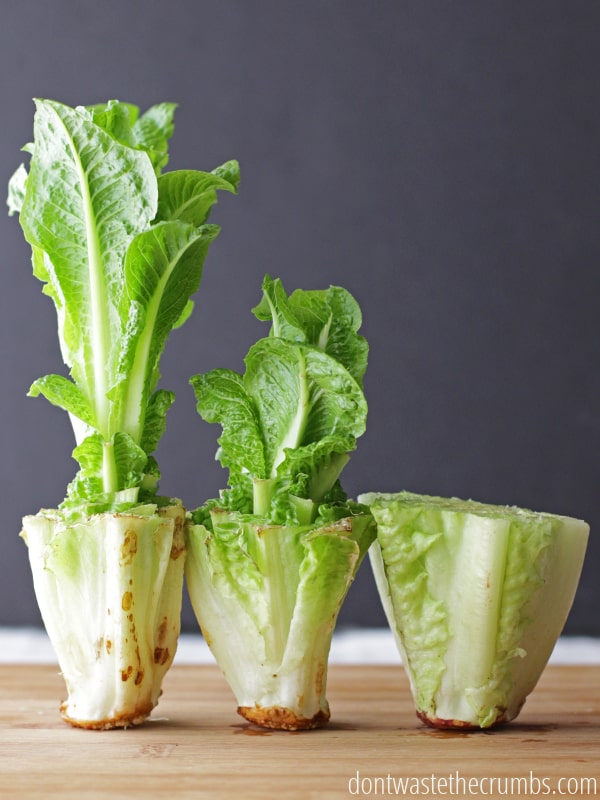
Got more scraps to regrow food?
There are plenty more vegetables that will regrow using just a small scrap of the original food. These listed below can be started in water, but should be transplanted to dirt for full growth and harvest.
- avocado
- basil
- beets
- cilantro
- ginger
- lemon balm
- mint
- mushrooms
- onions (white/yellow/red)
- parsnips
- pineapple
- potatoes
- rosemary
- sweet potatoes
- turnips
And of course, you can save the seeds/pits from apples, cherries, lemons, nectarines, peaches, peppers (sweet and hot), plums, pumpkins and tomatoes to grow your own new vegetables!
We have several heads of lettuce regrowing on our kitchen table, which makes for a pretty and practical centerpiece! If you had a shelf near a window, you could keep all your plants there and just harvest when they’re big!
Just think – if we did all of the above ways to regrow food, we might not ever have to shop at the grocery store again!
It’s so easy to regrow food in water!
- You’ve worked hard to grow your garden or pinch pennies to afford organics or are doing the best you can with your budget — now it’s time to stretch those dollars even further and grow food in water!
- Start with one of these shallow dishes or these taller dishes. Add in the food stumps (see above for details!). And keep the water fresh.
- Fertilizer could help if you really want to work this system. This Dr. Earth organic liquid fertilizer or a hydroponic fertilizer would work well.
- If regrowing your food in water isn’t your skill set, use those kitchen scraps to make chicken stock!
Need ideas on how to preserve those extra vegetables?
How to Blanch Greens // DIY Celery Powder // How to Keep Fruit (and Vegetables) Fresh Longer
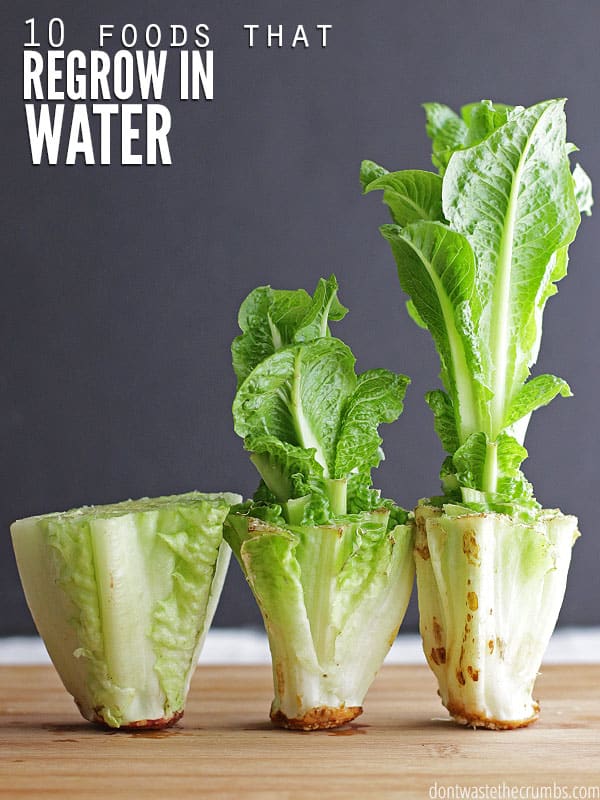





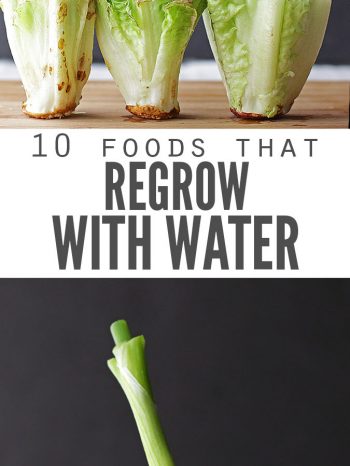
This never seem to works for me. Once they start to grow new leaf, the stem will start to rot.
It helps if you change the water multiple times a day and trim away extra stems. This also makes them less appealing to bugs, but it often makes it all not worth the effort. Onions can also start to smell if you aren’t diligent with water, but they will grow outside until hard winter frost with no tending beyond watering and come up again in spring.
While it is fun to watch, this is not a good source of food supply. Vegetables get their nutrients through soil and sunshine; you will not be getting any nutrition from regrow not veggies in water. You could start them in water and then transplant to soil but will still be void of as much nutritional value.
I have my celery started in a shallow bowl. I wish I would have know that you can grow green onions the same way. I just put a bunch of the roots in my compost pile. Oh, well next time. I’m also going to try the lettuce. Thank you for this information!
You’re most welcome Brenda!
It’s fun to regrow food and while it may save a little money I’d be concerned about the nutrient content of plants growing only in water. I think that is why you can only regrow them one time. The inner leaves probably use up any nutrients left in the outer leaves, then all is depleted. You may end up with more nutrient rich veggies if you stick it in a pot of good soil after you see roots appear or just put it in the soil from the start and keep moist. I’ve done it the latter way.
Yes it is delightful to grow your own food. Especially like you said for free! I have the best luck with green peppers red peppers
Lettuce garlic
And celery. All growing inside in January. Perhaps year round.
Still working on that. Thank you for your article!
Well said !!
The celery takes at least a couple of years to grow, so be patient. Also it would behoove you to know what soil to plant the potential foods in. Some like different soils.
Hi there! I love this post and will definitely be trying it out. I’m on holiday at the moment and it’s driving me crazy that I can’t just go and start this up straight away!
A quick question about the fertilisers: I have a vermicomposting bin (worms to the rescue) and a by-product of the compost you get is liquid that is very rich in nutrients. I’m not too sure what this liquid is but I know it can be diluted into a plant fertiliser that works well in soil, but would it work well in tiny amounts in the water too?
I don’t garden and hate wasting it so would love if I could use it for this!
I haven’t tried it myself Flora, but if your only option is to waste it, I’d give it a shot!
I tried what you said…with red onions. it turned out to be failure.roots were grown but then it started rotting. i tried many batches ending with same result. What should I do?
they are scallions..not chives 🙂
Scallions have an onion not garlic flavor. If I want something a little stronger than chives but not as strong as onions I use scallions.
Question. My shop bought parsnips have started to root from the side. If I plant the cut out pieces will I get some quick start parsnip plants?
You might Gennie! Parsnip is a root veg, so you’ll have to replant into dirt for sure (not just water), but you might sprout some leaves and future veg. It’s worth a shot!
Great post!! I tried celery last year, but wasn’t successful. I also tried green onions and they were super easy to regrow. It was the gift that kept on giving. We just put the root of a head of romaine lettuce in a small dish of water last night. We’ll see how that works out.
This is great. Always looking for a way to save those dollars..
Hi Tiff, good idea. Can’ wait to start.
I’m regrowing celery and saw on another website to eventually place it in soil after about a week.
2 Questions: do you move your plants to soil or do you keep them in water forever?
Also,
Another commenter on a different website said that growing veggies for too long can deplete the nutrients in the soil so much that the plant wont be flavorful. Any validity to this statement?
Hi Simon – when I regrow from scraps, I don’t transplant to soil. I consider it a fun experiment that I enjoy watching. If I was serious about regrowing and adding to my garden, I’d transplant for sure. I’m not a great gardener, but I haven’t heard that growing veggies for too long can lead to loss in flavor. 🙂
Growing the same vegetable over and over in the same soil depletes a finite set of nutrients peculiar to that plant. That’s why farmers rotate crops. In other words, swap pots and plants every other year. Organic fertilizer is good, too.
One thing: garlic chives are not just the greens from garlic. Chives and garlic chives are relatives of garlic and onion and leek and shallot, but not same thing.
Hi, I would love to grow mushrooms, how do I go about it?
Thanks
I’ve tried celery several times, but the root always ends up rotting. I use minimal water. I get new shoots or stalks starting, but the bottom piece always gets moldy and rots from the water. Any suggestions?
Plant it in dirt, in a pot. This will allow the roots to stay drier…
Quite interesting would like to try it.
I’ve had success regrowing green onions and celery this way. Now I’m going to try romaine. I’ve learned that I need to use a clear glass container, and change the water every other day. I have a water softener for hot water, and a drinking water system, so I make sure to dump out old water and refill with the cold, hard, regular water, which will be more mineral-rich. People having problems – it could be your container, your water, or you may not be changing the water often enough.
I know that lettuce is generally not all that nutrient-rich, but does regrowing lettuce without soil further minimize the nutritional value?
You won’t get much when you regow Farid, so the point isn’t necessarily to get a ton of nutrients, but to really get the most you can out of the food you buy.